|
NOTE: All wines tasted at this event were provided by the sponsoring wineries. Please see my page ' Submissions, Reviews, Invitations & Disclaimers'. Many of us are ‘seasonal’ wine drinkers; in other words, we tend to drink cozy reds in the winter and lighter, more refreshing wines in the warmer months. Not only do these choices fit our mood but also the food selections we make. With this in mind, the Wine Review Council met on a classic Southern California July evening to sample a selection of wines perfectly paired to our relaxing poolside setting. All the samples hailed from California, from producers large and small, both established and new and the evening brought a few surprises. Both the first and last wines were versions of Viognier from one of the newer wineries in Southern California, Estate d’Iacobelli (pronounced “de Yack-oh-belly). This small establishment opened the doors of their tasting room this past May, located in the town of Fallbrook, located between San Diego and Temecula. The owners, Ronei and Lisa Iacobelli, are originally from Michigan, but their love of wine and Italian heritage brought them to the Temecula Valley in 1998 where they bought 20 acres and planted vines and olive trees. They decided, however, to build their tasting room on a beautiful hillside overlooking the Pala Mesa Golf course. The 2011 Estate d’Iacobelli Viognier is refreshingly fragrant with crunchy green pear, orange blossom and peach leading to a somewhat creamy palate with nectarine and lime zest on the finish. Not your typical Viognier, but delicious just the same. Retail $32.00. The companion wine, 2010 Estate d’Iacobelli “Sticky Fingers” LH Viognier was a terrific finish to the evening. Baked pear and nutty cashew mingled with lemon drop! The finish was not syrupy or overly sweet. It would make a perfect ‘little something’ after dinner. Retail $26.00. Both wines are available at the tasting room or through their website. Moving further north to Mendocino, we sampled three offerings from Moniker Wine Estates. A creation of three generations of the Thornhill family, the name and logo honor the multiple generations working together to create this premium line of wines. First up was the 2012 Moniker Chardonnay. The majority of the fruit was sourced from the Ribera vineyard located on the banks of the Russian River. The wine was barrel fermented for four months in American oak and, prior to bottling, blended with a bit of Viognier and more Chardonnay that was aged in French Oak. The result is a subdued and somewhat elegant Chardonnay, with soft apple, spicy cinnamon and notes of baked pear. The sur lie aging lends a soft mouth feel and good acidity keeps the finish fresh. Retail $23.00 Pinot Noir is always a great choice for summertime cuisine and the first one we sampled was also from Moniker. The 2012 Monkier Pinot Noir is a blend of grapes harvested from three Mendocino vineyards located in Anderson, Redwood and Potter Valleys, aged in American oak for seven months. The wine is all red fruits – rhubarb, cherry and red plum, highlighted with notes of fresh tobacco and tealeaf. Retail $30.00 Our last selection from this producer was the 2011 Moniker Cabernet Sauvignon. Although I wouldn’t normally consider this variety as a ‘summer sipper’, one can never say no to a California Cab! This bottling received Double Gold at the 2014 San Francisco Chronicle Awards. Aged for fourteen months in three year old French oak barrels, the wine lets the fruit do the talking. Black cherry, spicy plum and vanilla notes on the nose and palate linger on to the finish. This wine would definitely benefit from some more time in the bottle to fully show itself. Retail $30.00 From newer wineries on to a familiar name in the pages of California wine history: Wente Vineyards. Founded in 1883, Wente is the oldest continuously family owned winery in the United Sates. They began with 47 acres, planted by founder C.H. Wente and have now grown to 3000 acres, still in the Livermore Valley AVA. The Wente family have always contributed to the growth of the wine industry: first to put the grape variety name on the label, founders of the California Wine Institute and of course, the development of the now prolific Wente Clone of Chardonnay. They were honored as the American Winery of the Year in 2011 by Wine Enthusiast Magazine and in 2010 became a Certified Sustainable Vineyard, part of their “Family for the Future” campaign. To be honest, I had not tasted any of their wines for a very long time. Call me a snob, but I just hadn’t. I was in for a pleasant revelation. We first sampled the 2012 Wente Riva Ranch Chardonnay. This is part of the “Heritage Block” Series utilizing grapes from vineyards named after some of the pioneers of Wente winemaking. They are located in the Arroyo Seco region –considered one of the prime Chardonnay areas since the 1960s. The grapes were fermented in a combination of French, American and Eastern European barrels and stainless steel. The result is a tasty, New World Chardonnay. Vanilla beans, soft toast, baked apples with nutmeg and hints of tropical pineapple. Retail $22.00 The second sample from this historic producer was the 2012 Wente Morning Fog Chardonnay. Named after the cooling mist that flows from San Francisco Bay over the vineyards of the Livermore Valley, the wine is aged half in stainless steel and half in new French, American and European oak barrels. All the wine is aged sur lie for seven months. Elegant and enticing soft apple, lemon curd and spicy ginger show on the nose and palate with soft toasty, brioche, peach and applesauce lingering on the finish. Part of the ‘Vineyard Selection’ Series. Retail: $12.00 Our third and last taste of Wente was red - the 2012 Wente Reliz Creek Pinot Noir. The fruit once again is sourced from the vineyards of Arroyo Seco in Monterey. The soil here is gravelly loam with shale and limestone, lending structure and minerality to the wine. The wine spends twenty months in a blend of French and European neutral oak. The lovely cherry red hue matches the perfumy nose filled with cherry, black raspberry, and toast. The palate is deeper with notes of raspberry preserve, dark strawberry and earthy note of kirsch. The finish is clean with touches of white pepper. All in all, a feminine, Old World influenced Pinot. “Heritage Block Series” Retail: $28.00 At the end of each Wine Review Council tasting, we all rank the wines according to our personal preferences. For once, the votes were all swayed in one direction: the Wente Way! First place went to the Wente Reliz Creek Pinot Noir, with the Morning Fog and Riva Ranch Chardonnay’s sliding into second and third. Varietal character, value for money and food compatibility lead to most of our conclusions, So, until next time, happy sipping, whatever the season. NOTE: All wines tasted at this event were provided by the sponsoring wineries. Please see my page ' Submissions, Reviews, Invitations & Disclaimers'.
1 Comment
NOTE: All wines tasted at this event were provided by the sponsoring wineries. Please see my page ' Submissions, Reviews, Invitations & Disclaimers'. Here we go with Round Two of the Wine Bloggers Conference speed sipping, slurping, spitting and blogging extravaganza. As with the whites, we were given five minutes to absorb not just the wine itself but also the story of the winery and the process of the winemaking. A challenge, to be sure, but a good one. So I present to you the ten wines brought to our table, just as they were described at the time (with typos corrected to protect the innocent). 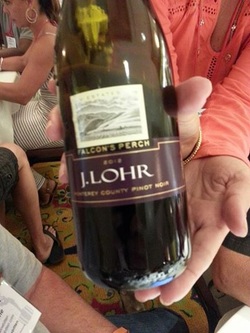 J. Lohr Pinot Noir J. Lohr Pinot Noir J Lohr Falcon's Perch Pinot Noir 2012 Award winning and inky $17. Slighty smokey- succulent silky strawberry. 13.5% alcohol means really drinkable. Can we say BBQ salmon with something chocolaty for afters?  Westerly from Santa Barbara County Westerly from Santa Barbara County Westerly Fletcher's Red 2010 Bordeaux style blend from Happy Canyon AVA . Black juicy berry meets licorice and black plum. Dark cocoa and earth and terrific balance of fruit acid and tannin keeps this rich and balanced. Sip alone or try with some braised short ribs. Winemaker hails from Harlan Estate. Need I say more? 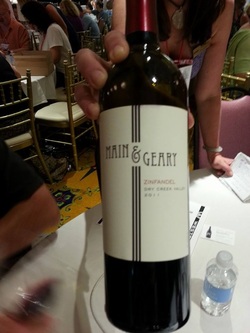 BevMo's own from Sonoma BevMo's own from Sonoma Main and Geary Dry Creek Zinfandel 2011 Big and plush palate zin from BevMo Private label series $19.95 and even less when you go to the 5 cent sale. Heat up the grill and get your party started with this very quaffable wine.  Not your typical Napa winery! Not your typical Napa winery! Cornerstone Cellars 'The Cornerstone’ Napa Valley 2011. Releasing this September & made to be aged for 10 years plus. Blend Cab Sauv/ Merlot/ Cab Franc. Everything is there: acidity, tannin and plummy cassis fruit blending all together. Balanced wine to savor in the years to come. Only 100 cases.  Little Winery, Big Hart. Little Winery, Big Hart. White Hart Pinot Noir 2012 Santa Lucia Highlands Central Coast 2012 40 year old vines in this cooler AVA brings out dark strawberry aromas with juicy red currants and subtle clove nutmeg spice. An elegant feminine Pinot made for sipping or cuisine. Delicious.  Photo Courtesy of Banfi Wines. Photo Courtesy of Banfi Wines. Banfi Centine Rosso 2012 Banfi Wines are in the house. Sangio-Merlot marriage is your everyday "let's have some wine with dinner" vino and at around $10-12 you can make this tasty little fellow your house wine. The soil is limestone dominant so we have great structure welding together cherry, berry and a bit of tar with great palate cleansing acidity. Bueno.  Saperavi is the variety - Marani Winery Saperavi is the variety - Marani Winery 2008 Satrapezo Saperavi from Georgia - the country! The grape is native to Georgia and the juice as well as the skin is red giving the wine a deep opaque hue. Rustic and earthy with plummy notes. Interesting. 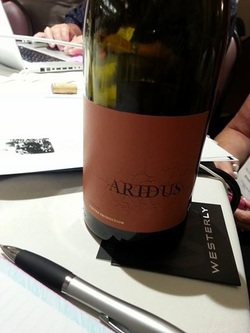 Aridus Syrah from Arizona Aridus Syrah from Arizona Aridus 2012 Syrah The winery is in Arizona but while they wait for the vines to produce they have sourced from the Russian River for this vintage. Dried sage herbs and black fruit with solid tannins would be good compliment to grilled meats and root veg.  Family Reserve Cabernet Sauvignon Family Reserve Cabernet Sauvignon Charles Krug Howell Mt Cabernet Sauvignon 2011 Broody and big with dark fruit and cocoa tobacco leaf. A touch of Petit Verdot and all French oak ups the anti on this voluptuous red. Prime Rib is calling.  Ottimino-Exclusively Zinfandel Ottimino-Exclusively Zinfandel Ottimino Vineyard 2011 Russian River Valley Zinfandel Cooler climate means longer, slower ripening so higher acidity and low alcohol- for a Zin!! Dark strawberry jam and cassis with black Dutch licorice, tealeaf and vanilla bean. Thinking some Tex-Mex. NOTE: All wines tasted at this event were provided by the sponsoring wineries. Please see my page ' Submissions, Reviews, Invitations & Disclaimers'.
NOTE: All wines tasted at this event were provided by the sponsoring wineries. Please see my page ' Submissions, Reviews, Invitations & Disclaimers'. How many wines can you taste, describe and put into the social media stratosphere in, say fifty minutes? If you had been attending the 7th Annual Wine Bloggers Conference in Santa Barbara County, CA a few weeks ago, you would have to say ten, because that's exactly what we did! The theory is this: bring together over 300 wine bloggers from around the world and seat them at large round banquet tables in the ballroom of the Santa Ynez Marriott. Every 5 minutes, have a winemaker or winery representative come to the table to pour wine samples and talk about the wines and the winery. The bloggers taste and assess, then Tweet, blog or Facebook their comments about the wine (plus any other interesting tidbits they can squeeze in) and the process is repeated. The action reached a fever pitch after about the second wine as everyone asked questions, swirled, and sipped while tapping away on smartphones, tablets and laptops. Day one was for Whites and Rosés. Sadly my table didn't see any pink wines but we reviewed an interesting array of whites. Here, with typos corrected, is a recap:  Bianchi Pinot Grigio 2012 Bianchi Pinot Grigio 2012 1) Bianchi Pinot Grigio 2012. Smooth but palate fresh. Dried grasses mingle with citrus ripe melon and somewhat cozy finish coming in at 13.7pc alc. Go Paso.
 Bandit Pinot Grigio 2012 Bandit Pinot Grigio 2012 3) Bandit 2012 Pinot Grigio Tetra Pack time. CA grapes-Napa Sonoma and Central Coast. Enviro friendly is great and at 8 bucks retail cud work for picnic. Light refreshing and crisp.  Leatitia Brut Cuvee NV Leatitia Brut Cuvee NV 4) Laetitia Brut Cuvee NV Sparkle time. Chard Pinot Noir and Pinot Blanc from Arroyo Grande. Cool green apple and soft peachy fizzle. Sustainable vineyards and great cool climate make good sparkling. Fun and frothy.  Consilience Viognier 2012 Consilience Viognier 2012 5) 2012 Consilience Viognier All local Santa Barbara AVA fruit vinified to make food friendly vino. Neutral French oak - 14 months gives soft vanilla spice, cinnamon toast to go with ripe plump apricot. Voluptuous as Viognier shud be but nice acidity keeps to that food friendly vibe and goal.  Rios de Chile Sauvignon Blanc 2013 Rios de Chile Sauvignon Blanc 2013 6) Rios de Chile 2013 Sauvignon Blanc Minimal intervention to keep varietal character. AM fog and proximity to the sea show in crisp clean granny smith apple and citrus peel notes. Grantic and sandy clay soils. Great food-seafod-salad wine. Try it- I will.  Jordan Russian River Chardonnay 2012 Jordan Russian River Chardonnay 2012 7) Jordan 2012 Russian River Chardonnay 40pc new French oak for 4 months keeps this approachable and food compatible. Really racy acidity enhances nuanced fruit. Super summer fare companion and might make your ABC friends change their minds.  Buttonwood 'Zingy' Sauvignon Blanc 2013 Buttonwood 'Zingy' Sauvignon Blanc 2013 8) Buttonwood Zingy Sauvignon Blanc 2013. All estate fruit - all stainless and cool ferment. Hence the name Zingy perhaps? Laid back aromas of green melon and crisp apples. Bring on the fried chicken and potato salad!  Aridus Malvasia Bianca 2013 Aridus Malvasia Bianca 2013 9) Aridus Malvasia Bianca 2013 Arizona's challenging climate and high elevations are no threat to Aridus Winery of Cochise County. Grapes from New Mexico. Neutral oak for few months but still highly aromatic. If you love Moscato you will flip for Malvasia - fruit salad in a glass with clean finish. 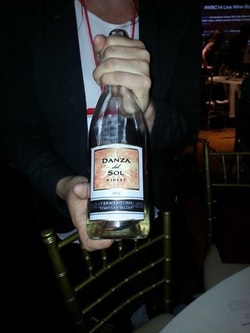 Danza del Sol Vermentino 2013 Danza del Sol Vermentino 2013 10) 2013 Danza del Sol Vermentino Temecula Valley. I have to like this or they will kick me out of my house right? Lime and tangerine on big nose. All stainless shows peachy palate. Come to Temecula and grab a glass on the patio. So, there you have it. Ten wine reviews in 50 minutes. It was noisy, challenging and a lot of fun. So much fun that we repeated the exercise the next day with reds! Stay tuned for part 2, coming soon.
NOTE: All wines tasted at this event were provided by the sponsoring wineries. Please see my page ' Submissions, Reviews, Invitations & Disclaimers'. Disclosure: Wine tasting is a highly individual experience and, scientifically, none of us perceive wine in exactly the same way. The opinions expressed in this post are mine and mine alone and although the wines sampled were supplied by the designated wineries for review I describe them as I see them. 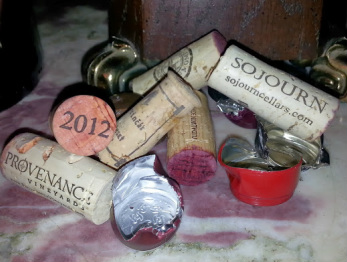 When you are a wine educator it’s natural that people ask you a lot of wine related questions. One of the most frequent queries has to do with price. Why, people ask, does one Chardonnay/Merlot (insert variety name here) cost more than another? Is it really worth paying more? A while back, the Temecula Wine Council tasted a selection of wines that had one thing in common: they were all over $40 retail. Considering that the average price paid for a bottle of wine is around $6.30 1 to many imbibers out there, these prices are a splurge. So let’s have a look at the wines we sampled and see if we can answer this burning question!  First up was a non-vintage white wine from Paso Robles, “Le Cuvier XLB Chardonnay Reserve”. (retail $55). The grapes were fermented with their skins, somewhat unusual for a white wine, and then barrel aged for 5 years. The end result is a big, bold interpretation of Chardonnay, orangey gold in color and meant for food pairing rather than leisurely sipping. It would be a good match for hard cheeses or spicy hummus. Másut Vineyard & Winery in Mendocino California is owned by the third generation of the well-known Fetzer family – Ben and Jake. Their 2012 Pinot Noir (retail $40) is produced from organically farmed estate vineyards. The yield is low, about 3 tons per acre and grapes are all hand sorted. This attention to craft continues through the winemaking stage and the wines are aged in 33% new French oak barrels for 10 months. The result is a New World style Pinot with dark silky berry notes showing a hint of clove, cigar box and kirsch. This wine was paired with Mushroom Risotto, which was terrific, as were some spicy lamb meatballs. Another Pinot Noir followed, this time from the Sonoma Coast. Sojourn Cellars Sangiacomo Vineyard 2012. (retail $54) This is the flagship vineyard for Sojourn with low yields and high quality fruit. Berries are sorted in the vineyard and again after harvest leading to small lot fermentation and barrel aging. This Pinot shows ‘Old World’ flair – soft strawberry, cherry and dried raspberry fruit, with rose petal and earthy, forest tones. In classic, Burgundian style it proved to be a great sipper and was equally at home with savory ‘gourgere’ cheese puffs, as well as the risotto.  Staying in California, we moved on to Tudal Family Winery ‘Cliff Vineyard’ Cabernet Sauvignon 2010. (retail $65) This small, two acre, vineyard, lies just north of Napa in the Oak Knoll district and yields a small 200 cases. Aged for 12 to 18 months in 80% French and 20% new American oak barrels, this wine has a gorgeous deep garnet color. Aromas of ripe forest fruits and vanilla lead to walnut, humidor and roasted green pepper on the palate with medium tannin. Bolognese stuffed Bell Peppers were a terrific compliment to the wine. Another Cabernet followed, also from Napa, Ca’ Momi 2011 Reserve Cabernet Sauvignon (retail $65). This winery was started in 2006 by three Italian winemakers who fell in love with Napa. After consulting and working with many of the finest growers in the area, they decided to produce their own wines and knew the best fruit to source. The 2011 Cabernet has lots too offer – jammy berries and dark currents, with tones of tobacco and dried sweet grass. It paired well with the food offerings at hand but I think it would be a terrific choice with the wonderful offerings at Ca’ Momi’s ‘Enoteca’ in Napa! Provenance Vineyard’s Cabernet Sauvignon ‘Oakville Beckstoffer to Kalon Vineyards’ 2010 (retail $89) was our last red of the evening. With fruit hailing from one of the most historic vineyard sites in the Oakville region of Napa, the wine is a true American Cab. Deep ruby hues meet rich blueberry and black fruit, laced with fresh sweet baking spices, toasty oak and licorice. The tannins are supple and refined making this a fantastic, versatile choice for food or to savor on its own.  Our last selection was a complete departure both in style and geography – a Czech ‘Straw wine’. Slámové Vino, Ryzlink Rynsky from Mercincak Winery. (retail $63 for 375ml) This rich and refreshing dessert wine is created with Riesling grapes that are harvested late in the season so the berries are high in sugar and low in water. The clusters spend four to six months resting on straw mats. During this stage sugar levels increase before the grapes are crushed. The fermented wine is then aged in barrel. The result is a wine moderate in alcohol, around 11% and very high in residual sugar! This winery is the largest Biodynamic grower in the Czech republic and has been specializing in traditional grape varieties and styles since 2008. This incredible attention to detail shows in the beautiful balance of the wine. The fresh acidity ensures that the sweetness doesn’t overpower, so you have a silky nectar filled with aromas and flavors of tropical fruits, rich citrus and fragrant honey. A tropical fruit trifle proved a tasty companion. So, what was it about these wines that merit the price? A combination of elements can contribute – extended barrel aging and the continuous attention of the winemaker, new (and pricey) oak, hand sorting of the grapes both in the vineyard and at the crushpad, small lots and sought after vineyards. All these wines shared a common denominator: dedication to quality. That’s something you probably won’t find in a $4 bottle! 1 “Consumer Wine Trends” Erin Guenther, winebusiness.com Jan. 21/2013  One of the great perks of being involved with the wine industry, in all its many permutations, is the chance to taste and learn on a continual basis. Most of the offerings from wineries, especially larger producers or those affiliated with the more ‘corporate’ establishments, are focused on sales. After all this is the wine ‘business’ and without sales we would all in a sad state. But every now and again an invitation appears for a more ‘educational’ experience and these are the ones that get me excited. Such was the case last month when I attended the “Sommelier Series” event sponsored by Chalone Vineyards. The seminar was held at the stunning Lodge at Torrey Pines in La Jolla, CA. This elegant, craftsman-style resort is home, I’m told, to a legendary golf course but my focus was on the wines! 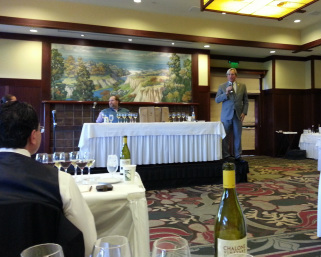 The workshop was conducted by Robert Cook, Winemaker for Chalone and Gilles de Chambure MS with a comparison tasting of several vintages from Chalone Vineyard and wines from Bourgogne.  Chalone Vineyards were first planted in 1919 by Frenchman Charles Tamm. It seems he was searching for soil that reminded him of his native Burgundy and found them in this limestone rich terrain in the shadow of Pinnacles National Monument .  Today, these are the oldest producing vineyards in Monterey County and produce award winning Chardonnay and Pinot Noir, just as Monsieur Tamm had dreamed of! In 1966, under owner/winemaker Dick Graff, Chalone set the standard for California Chardonnay and today, although it is owned by a large corporation (Diageo Chateau & Estate Wines), the wines are still crafted with respect for both the vineyard and the distinctive terroir. These wines certainly held their own when tasted against two delicious vintages from Burgundy and the passion of both gentlemen enhanced the experience. I shall be writing more extensively on the terroir, history and vintages of the Chalone AVA in the near future (more on that to come - stay tuned!). A big “Thank you” to Angela Bortugno and Lauren Watters of Chalone Vineyards for organizing a well orchestrated and classy event. Speaking to the other Sommeliers and educators, it was a terrific experience all around and Chalone should expect quite a few industry visitors in the months ahead. During these hot days of summer, I’m always on the prowl for crisp, refreshing whites and rosés. As I perused the shelves the other day, I came across a distinctively shaped bottle: tall and slender with the cross of Languedoc embossed on the neck.
This special bottle is indicative of the largest white producing area in the Languedoc region of Southern France – Picpoul de Pinet. A ‘Crus’ of the Coteaux de Languedoc, the area is named after the varietal Picpoul Blanc (aka Piquepoul Blanc or “Lip Stinger”) which has grown in these vineyards since at least the 17th century. The 3000 acres of vines are divided into two areas by a famous ancient Roman road called the “Via Domitienne” which, during that era connected the capital of Rome to Spain. Vineyards to the north are limestone, giving the grapes terrific acidity while those to the south lie on more flat, sandy deposits where the heat is tempered by Mediterranean breezes. 2011 La Domitienne Pique Poul, Picpoul de Pinet, Languedoc Bright and lively with aromas of ripe peaches, softly scented white blossoms and sea-spray, the palate shows deep lemon peel and touches of blanched almond all wrapped up with a refreshing saline minerality and bracing acidity. Naturally, the wine would be perfect with seafood and shellfish or perhaps a crisp salad but at our house the wine was paired with music – in vinyl form; Boomtown Rats “A Tonic for the Troops” and Audience “Lunch”.  I came upon an interesting article today “Rosé wine, you’ve come a long way” from the Telegraph of London. The writer, Victoria Moore discusses, among other things, how this style of wine generally considered a “swimming pool wine” but has suddenly risen into the strata of “chic”, partly due to the release of Angelina Jolie & Brad Pitts new vintage, “Chateau Miraval". One reason I read the article was because I have been studying for my Master Level Provence Instructor accreditation, so I am obsessive about these things; I dream of the soil types of Provence and the various production methods. Sad, I know, but I do get to sample some fabulous wines as part of my ongoing research and education! The other reason I found this piece from the British media of interest is because the fashion for ‘drinking pink’ is really nothing new at all- in fact, when the area of Provence was first settled, viticulturally speaking, red wines were not really ‘red’ as we think of them. Grapes were processed very quickly after harvest and, as archeologists are verifying, most of the wines of the ancient world had just a little color. As for being ‘chic’, rosé was always the choice of the elite and the well-healed. These pale wines were the favorites of the Russian Imperial Courts and no self respecting aristocrat would drink a deeply hued wine, at least not until near the end of the 19th century. The lighter wines were drunk for pleasure while the poor soldiers and peasants were given “Piquette” made from adding water to the pomace or pressed skins and seeds of the rich-man’s wine. So get ready for the new 2012 vintage and sip some rosé. You’ll be chic, just like the citizens of Provence have been for, oh, about 2600 years! http://www.telegraph.co.uk/foodanddrink/9971135/Rose-wine-youve-come-a-long-way.html?fb Illustration courtesy of the Chrysler Museum of Art "detail from Hendrick van Schoel's 1590 engraving Autumn from The Four Seasons, showing the ancient process of wine-making which made this region so famous.  Three weeks from now, beginning July 25th, I will be sitting in a hotel conference room, surrounded by like minded wine geeks (and I use the term lovingly because I am one myself) absorbing knowledge like a giddy schoolgirl. Hopefully, this euphoria will not come just from the fantastic wines that I’ll be privileged to taste, but from the amazing symposiums I will attend. I will take “A Fast & Deep Dive Deep into California’s Appellations”, taste “The Great Wines of Spain”, travel through “Provence: Ancient Roman Roads to Modern Biodynamics” and “Island Wines: Off the Beaten Path”. Other session will aid me in transferring all this information to my students with “A Revolutionary Way of Teaching the Wines of France” and rev-up my seminars by going “Beyond Classes with Glasses: The Wine Educator’s Tool Belt”. As you can tell, this is an event that I am looking forward to immensely and I can’t wait to meet all the other 381 attendees, spend three un-interrupted days sitting at those tables with a row of glasses before me and a world of wine to explore. “Who dares to teach must never cease to learn.” John Cotton Dana |
AuthorWine lover, educator and writer. Archives
March 2017
Categories
All
|



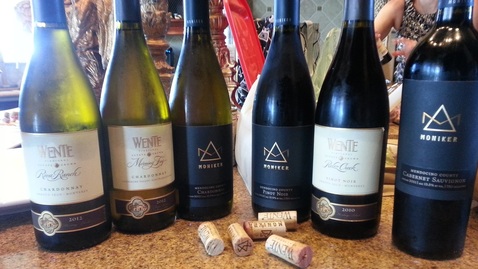



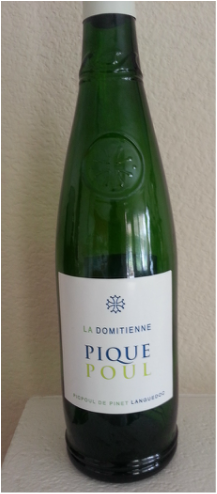

 RSS Feed
RSS Feed

